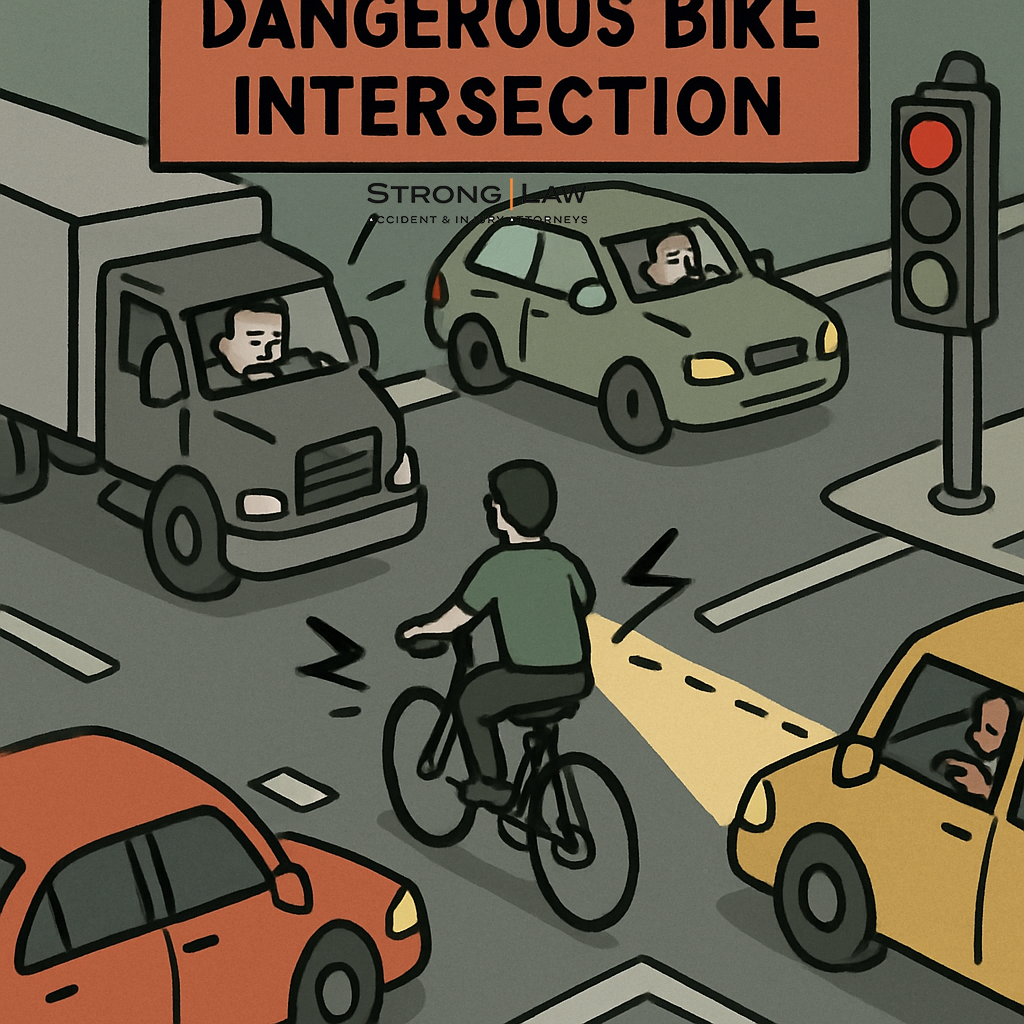Most Dangerous Intersections for Cyclists in Eugene, Oregon

Eugene Bicycle Accident Lawyers
Takeaway: Eugene is bike-friendly, but busy intersections raise crash risk. This page shows where crashes happen, why they occur, what laws apply, what to do next, and how our attorneys can help.
Eugene offers scenic paths, bike-share, and a strong cycling culture. As ridership grows, so does the chance of collisions—especially where cars, bikes, and pedestrians meet. Use this guide to scan safety tips, high-risk locations, and the legal steps that protect your claim.
Why Bicycle Accidents Happen at Intersections
Summary: Most crashes involve turns across bike lanes, limited visibility, distraction, higher speeds, or gaps in design/maintenance.
- Left-cross & right-hook turns. Drivers misjudge speed or turn across bike lanes/paths.
- Limited visibility. Parked cars, signs, landscaping, and large vehicles create blind spots; rain and darkness make it worse.
- Distraction. Texting, calls, and in-car screens pull attention from cyclists.
- Speed & complex lanes. Wide multi-lane intersections invite fast driving and expose riders.
- Design/maintenance gaps. Faded paint, debris, potholes, and missing bike signals raise conflict points.
See intersection safety guidance from the National Highway Traffic Safety Administration (NHTSA).
High-Risk Eugene Intersections for Cyclists
Summary: Risk increases where speeds, turning movements, and traffic volumes are high or bike facilities are incomplete.
Franklin Blvd & Walnut St
Near the University of Oregon. Heavy bike and foot traffic meets fast vehicle flows. Left-cross and right-hook risks are common.
13th Ave & High St
Along the 13th Avenue Bikeway. Riders mix with buses, deliveries, and cross traffic. Limited protection can lead to side impacts.
W 11th Ave & Bertelsen Rd
Commercial driveways and multiple turns at higher speeds. Watch for vehicles exiting shopping centers.
River Rd & Irving/Hunsaker
Wide lanes and long crossings encourage speed and increase exposure time. Limited dedicated bike facilities add risk.
Coburg Rd & Oakway Rd
High volumes and multiple lanes. Bike lanes end near turns, creating merging conflicts at peak times.
Beltline Hwy & Delta Hwy (interchange area)
Trails/frontage roads bring riders near high-speed merge zones. Small driver errors can have major consequences.
Explore statewide crash data via the Oregon DOT Crash Data Portal.
Common Injuries from Eugene Bicycle Accidents
Summary: Even low-speed collisions can cause head injuries, fractures, spinal trauma, and severe abrasions.
- Traumatic brain injuries (TBIs). Helmets reduce severity but cannot prevent all brain injuries. See CDC bicycle safety.
- Fractures & soft-tissue damage. Commonly collarbone, wrist, hand, leg, ribs; sprains, strains, and ligament tears.
- Spinal injuries. Vertebral or cord trauma can cause lasting pain or disability.
- Lacerations & road rash. Sliding on pavement risks infection, scarring, and extended wound care.
Always get medical care after a crash. Some injuries—especially head trauma—don’t show symptoms right away.
Key Oregon Bicycle Laws Every Rider Should Know
Summary: Bikes are vehicles. Use bike lanes when safe, signal turns, use lights at night, and note that helmets are required under 16.
- Bicycles are vehicles. Cyclists have the rights and duties of drivers (ORS 814.400). Obey signals and signs.
- Bike lane use. Use available bike lanes/paths when safe; exceptions for turning, passing, or hazards (ORS 814.420).
- Hand signals. Signal turns and stops (ORS 814.440).
- Helmet rule. Required under age 16 (ORS 814.485). Adults not required, but helmets reduce head-injury risk.
- Night riding. White front light ≥500 ft; red rear light or reflector ≥600 ft (ORS 815.280).
- Sidewalks & crosswalks. Allowed unless restricted locally. Yield to pedestrians; give an audible signal; cyclists in crosswalks share pedestrian rights/duties (ORS 814.410).
- No impaired riding. Alcohol/drug impairment is illegal and dangerous.
Read the full statutes: ORS 814 Bicycle Laws.
What to Do After a Bicycle Accident in Eugene
Summary: Get safe, call 911, get medical care, document the scene, and speak to a lawyer before talking to insurers.
- Move to safety. Exit the roadway if possible.
- Call 911. Police and medics create vital documentation.
- Get medical care. Accept on-scene evaluation and follow up with a doctor.
- Exchange details. Driver name, contact, plate, and insurance; collect witness info.
- Document. Photos/video of signals, debris, skid marks, bike damage, and injuries.
- Preserve evidence. Keep your damaged bike, helmet, and clothing.
- Don’t admit fault. Stick to facts with police; avoid insurer statements until advised.
- Contact an attorney. Early guidance protects your health and claim.
How Our Eugene Bicycle Accident Lawyers Can Help
Summary: We investigate, deal with insurers, coordinate medical documentation, pursue full compensation, and litigate if needed. No fees unless we win.
- Investigation. Police reports, witnesses, video, crash data, and expert analysis to prove fault.
- Insurance & claims. We handle adjusters and filings so you can focus on recovery.
- Medical documentation. We coordinate with providers to capture current and future care needs.
- Full damages. Medical bills, lost income, diminished earning capacity, pain and suffering, and property loss.
- Trial-ready. If a fair settlement is refused, we file suit and advocate in court.
- Contingency fee. You pay nothing unless we recover compensation.
Related resources:
Eugene Personal Injury Lawyer,
Eugene Car Accident Lawyers,
Eugene Truck Accident Lawyers,
Eugene Uber/Lyft Accident Lawyer,
Eugene Wrongful Death Lawyer.
Our team has recovered millions for injured Oregonians. From day one, you get clear guidance and strong advocacy.
Frequently Asked Questions
What is the statute of limitations for bicycle accident claims in Oregon?
Short answer: Most personal injury claims must be filed within two years of the crash (ORS 12.110). Claims against government entities can have shorter notice deadlines. Speak with a lawyer promptly.
Do cyclists have to wear helmets in Oregon?
Helmets are required for riders under 16 (ORS 814.485). Adults are not required. Helmet use reduces head-injury risk. Lack of a helmet does not automatically bar recovery, though insurers may argue reduced damages.
What damages can I recover?
Medical bills, rehabilitation, lost wages, diminished earning capacity, bike/property damage, pain and suffering, and—rarely—punitive damages. Every case is fact-specific.
What if I was partially at fault?
Oregon uses comparative negligence. You can recover if your fault is 50% or less, with compensation reduced by your percentage of fault.
Can I make a claim after a hit-and-run?
Yes. You may recover under uninsured/underinsured motorist coverage and through investigation (witnesses, cameras, police). Prompt legal help improves the odds of finding the driver.
Free Consultation
Summary: Hurt in a Eugene bicycle crash? Call our local office or request a free consultation online.
Strong Law Accident & Injury Attorneys — Eugene
Phone: (541) 748-8636
Request a free consultation
Cycling is one of the best ways to enjoy Eugene. Knowing where crashes occur—and how Oregon law protects you—can reduce risk and support your claim. If a negligent driver injured you, our team is ready to investigate and fight for the recovery you deserve.
Author: Derrick Powell


